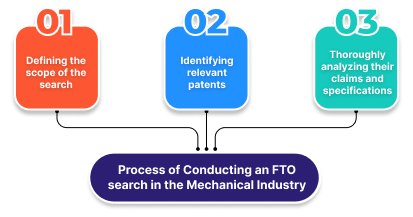“Engineering is not only about making things work, but also about making them work better.” – Henry Petroski.
Patent freedom to operate analysis plays an important role for companies in the mechanical domain to ensure a trouble-free market debut. With an FTO search, mechanical companies determine whether their new product, process, or technology infringes on existing patents and patent applications.
Before moving ahead with their research and development efforts companies hire reputable patent FTO search firms to identify existing IP rights their product or process might be infringing. An in-depth FTO or clearance search report serves as a lodestar for companies in navigating the complexities of intellectual property law.
Freedom to operate (FTO) also known as product clearance search, is a comprehensive analysis of existing patents and patent applications to determine whether a new product, process, or technology infringes them.
In the mechanical industry, the product clearance searches hold immense importance as new innovations or machinery are often built upon prior inventions. A detailed FTO report provides a safeguard against potential litigation and financial setbacks that can arise from inadvertently infringing upon someone else’s IP rights.

A patent expert while conducting an FTO search in the mechanical industry requires meticulous attention to detail. Conducting an FTO process in the mechanical domain begins with the following:
From exploring databases to analyzing patent literature and expert knowledge, an FTO expert must evaluate a comprehensive list of potentially relevant patents.
An FTO expert thoroughly examines the relevant existing patents/patent applications and compares them directly with the product, process, or technology in question. The patent expert examines the following;
And other important patent information must be carefully analyzed to identify potential infringement risks. In the mechanical industry, FTO searches often extend beyond patents to include other forms of intellectual property, such as trademarks and copyrights.
Following this approach, an FTO expert ensures comprehensive patent search coverage and mitigates potential infringement risks.
FTO or clearance search holds great potential for industries in the mechanical sector especially in decision making in due diligence processes like mergers, acquisitions, and licensing agreements. Mechanical companies take advantage of FTO search reports to have a clear understanding of the IP law domain, strategic planning, and market positioning. With an in-depth FTO report companies can push their R&D efforts and mitigate infringement risks.
Let’s take the example of company X which plans to develop a new line of vehicles featuring automatic gear transmission technology. Before starting the production of these new vehicles they conduct a FTO search to ensure that they don’t infringe on existing patents and patent applications. They hire a reputable freedom to operate search service provider to conduct a search on their behalf.
The patent Freedom to operate (FTO) search particularly focused on automatic gear transmission technology. The aim is to identify any existing patents that could pose obstacles or legal challenges to manufacturing and commercializing the automatic gear transmission system.
Find keywords related to automatic gear transmission technology, such as automatic transmission, gear shifting, transmission control, and more. Use these keywords individually or in different combinations on various patent databases such as USPTO, EPO, and other relevant international databases.
During this phase, the patent expert focuses majorly on two important aspects:
Company X conducted a competitive landscape analysis to identify patents held by competitors or other relevant stakeholders. With this, they can understand the overall patent landscape and potential licensing opportunities or risks.
An FTO expert analyzes the potential infringement risk of each identified patent w.r.t to company X’s automatic gear transmission technology. The detailed analysis includes the scope of patent claims, similarities between the patented technology and Company X’s proposed transmission system, and any potential prior art that could invalidate the patent claims.
The patent freedom to operate search identified several patents related to automatic gear transmission technology. The FTO report includes patents covering various aspects, such as;
Additionally, the competitive landscape analysis revealed patents held by key competitors in the automotive industry, indicating potential areas of overlap or conflict.
Based on the patent FTO report, an expert will provide the following recommendation to Company X –
The patent freedom to operate search provides valuable insights into the existing patent landscape surrounding automatic gear transmission technology, helping Company X make an informed decision. The company can identify potential infringement risks and opportunities for licensing or design modifications to navigate the complex IP law domain and ensure a trouble-free market debut. In a world where progress hinges on the ability to build upon existing knowledge, FTO searches guide the path toward future advancements.